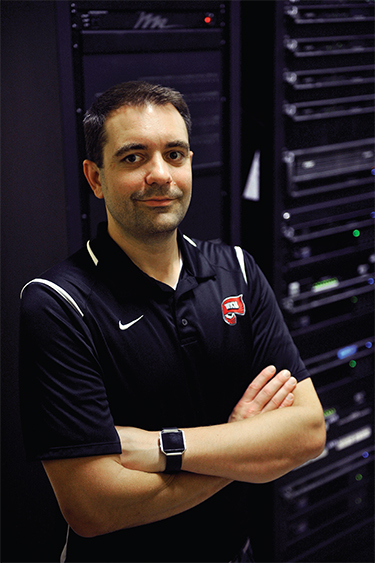We have heard the doom and gloom prophesies of the AV industry, and from multiple experts. We have heard about the death of the ‘integrator’ and about manufacturers not evolving quickly enough.

IMAGE: MICHAIL PETROV96
As a manager and an independent consultant with years on the front lines of pro AV, I can assure you: If your company is not willing to change, you will die. You have to be agile and adaptive.
Don’t take it from me, though. Let the facts tell the story.
AV Technology reported that InfoComm 2017’s attendance was up 14 percent from the previous year. Technology managers made up 41 percent of attendees, a record number. AVIXA recently released the AV Industry Outlook and Trends Analysis (IOTA)stating that through 2022, revenues will increase by over 4 percent annually.
If more people are attending InfoComm, more technology managers are coming to InfoComm, and revenue is expected to grow through 2022, why the bleak AV outlook?
Any possible AV extinction corresponds to customers that are more educated, expectations to do more with less, and the growing influence of IT/AV departments within large organizations. In conversations with other technology managers, we share strategies and techniques that allow everyone to become more efficient. This expands our knowledge base and helps us all become better at our work.
In the past five years we have seen multiple AV integration companies go out of business or get bought out by larger companies and then downsized. Manufacturers have downsized as well.
Why is this happening? Look to the influence of the technology manager, the customer experience, and the nature of the systems that are in demand today.
THE NEW TECH MANAGER

Justin Rexing, M.S., CTS-D, ISF-C, DMC-E-4K. Photo by Drew Thompson.
There are still a lot of audiovisual systems being designed, installed, and supported around the world, but no longer by traditional integrators alone. Older systems are being replaced, and new buildings require new AV solutions.
At Western Kentucky University where I serve as an Audiovisual Design Engineer, we design, install and support our own AV systems internal to IT—as a service to our clients or end users: the students, faculty, and staff. We have stopped asking for systems from integrators, and are now asking for boxes, cable, and sometimes labor, managed by us at an hourly rate if we need additional help on a larger project.
This is our response to poor installations and the resulting support tickets.
We have worked with some of the top integrators in the country. However, most of their highly qualified staff were assigned to more profitable projects. Our projects produced training opportunities for the integrator’s new hires, which hampered efficiency on our end.
Too many times an integrator told us they were complete and left before we could verify they had completed the job. There have been times where an integrator does not show up because of shifting construction schedules and we had to complete the AV system anyway. Some integrators subcontracted tasks to other contractors, contrary to established contracts. We have seen sloppy cabling jobs, no labeling, and constant programming glitches. I gave two companies a program and touchpanel interface file, and neither of them got it right. One integrator actually removed touchpanel pages from our standard because they thought the approach was better.
As more technology managers adopt in-house installation models, fewer services will be required of integrators, and more interaction with manufacturers will be needed.
EXCEPTIONAL EXPERIENCES
We found the best way to mitigate problems with integrators is to increase our internal labor force and complete the jobs ourselves. We also reorganized the way we handle projects versus support tickets.
We are now able to support our systems more efficiently, as we are the ones developing the configurations, programming, and documentation on those systems. More of our systems resemble one another. Designs, configurations, and installations are more standardized, which means the boxes matter less.
AV9000 Quality Management benchmarks and best practices is a great tool to use as a guideline, though it is not going to help an integrator leaving a job site when they think they are complete or make a sub-par integrator an amazing one. An educated and persistent customer will fix this problem, in conjunction with properly implementing standards.
If this sounds more like IT than AV … well … that’s where the market is heading.
We all try to deliver solutions to our clients that meet their needs and give them exceptional experiences. Whether you work in networking, servers and databases, phone systems, or AV, it is all about the experience. That is why network engineers are so careful about security procedures and policies. If the wrong device is thrown on the network, it could lead to a bad experience for many on our campus.
SYSTEMS DEMAND
These pressures coincide with decreasing budgets in higher education and finding ways to become more profitable as a corporation. Historically, audio-video systems have been custom. The CEO wants a special button to drop a disco ball, or the President wants a specific thing to happen. These requests now come more and more infrequently, as users demand plug and play capability. This results in less boxes sold. We have also been stocking our shelves with spare parts. This allows us to hot-swap something quickly when it fails, as we know everything will eventually fail. This also gives us time to work with the manufacturer through the RMA process, but still have an operational AV system. Therefore, we are not purchasing a new part, but maintaining an old one.
This process has also established more direct communication and support from various manufacturers to technology managers, further severing the ties of the traditional integrator. When a manufacturer insists we use an integrator, we drop the manufacturer. We just stopped using a speaker manufacturer due to this policy.
TAKE ON ALL TECH
My own company, Rexing Consulting Group, received a request to provide a background audio system for a new restaurant in Bowling Green, KY. The client first sought us out for high-quality background music. Going through proper needs analysis, we discovered they needed to control the audio wirelessly. They also needed a point-of-sale system, a security system, wireless network connectivity for their clients, and a fully functional AV system. As the primary consultant and solutions provider on this job, we made sure the wireless network was robust enough to handle their needs.
Rather than saying we didn’t provide certain solutions, we took all technology under our belt. We coordinated with other companies and contractors to install one IT system for the restaurant, including VLANs, AV networking, point of sale networking, a cloud-based VoIP system, and a camera surveillance system. By doing this, we were able to give the client a great experience, consolidate all cabling and equipment, create efficiencies in space, and provide one unified and sustainable system.
We could have installed our own small wireless access point and network switch that allowed communication between AV devices only, but that would have been shortsighted and would have resulted in competing wireless networks in one building. The client also would also have had to disconnect their wireless touchscreen from our audio network to connect to another network to access the web or other services. That was unacceptable.
OPPORTUNITIES STILL EXIST
We simply specify what makes sense, and not what is the most profitable. We do not have our own certified network engineers, nor do we have an experienced server-support team. However, when we see opportunity for additional revenue by providing more services under the IT umbrella, everyone wins. We find the resources needed to complete a single solution for our clients.
AV integration companies not thinking like this are missing revenue. Remember, we did not actually program the networking switches, but we looked out for the client and made sure our solutions made sense for everyone on the project. The network consulting company enjoyed the project so much, they brought us on other AV projects. We did not spend a dime in marketing to land this client.
So where do traditional integrators still have opportunities? In very large projects or one-time bids, smaller companies with an AV or IT department, and smaller school systems, especially K-12. Higher Ed and corporate technology managers are growing in numbers, which means IT departments see the savings of having the AV team on staff instead of contracting to outside vendors or integrators. This doesn’t just lower labor costs, but results in faster response times, more efficiencies and remote management, and less classroom downtime. This model will grow as more technology managers gain education and experience.
Technology managers are now better at developing RFPs and RFBs. They understand what a quality AV system looks like and how it performs. Faculty and staff are also requesting AV systems that utilize fewer boxes, which creates a template that can be replicated to produce more efficiencies. This means less programming and configuration costs over time and reduces the total cost of ownership.
If you are a traditional integrator and you’re not looking at your customer’s long-term goals to create simpler and more unified systems—you may not be in business much longer. Get Darwinian. This is about survival of the fittest and the most adaptive.
Justin Rexing, M.S., CTS-D, ISF-C, DMC-E-4K, currently works as an AV systems design engineer for Western Kentucky University. He is also the owner of Rexing Consulting Group. He holds a Bachelor’s Degree in Computer Information Systems and holds a Master’s of Science, both obtained from WKU. Justin has assisted in developing the AVIXA Networked AV Systems course, the Networking Technology course, and he currently holds senior faculty status with AVIXA. He has also presented at UBTech12 on standardizing project processes.
